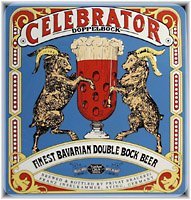Bock is German for male goat, a prancing symbol of spring fertility, and Bock beer is a malty German beer style, usually dark, which is brewed in the winter to be drunk in the spring.
It is now springtime. I think you know what to do.
 Bock beers originated in Einbeck, a northern German town that was a major trade center in the Middle Ages.
Bock beers originated in Einbeck, a northern German town that was a major trade center in the Middle Ages.
Einbeck is located in the middle of an early hop growing region, so Einbeck brewers used hops in their beer, which was unusual at the time. They brewed their beer in winter, so it was stored cold, which contributed to the beer's clarity, and the hops
added a preservative agent that allowed Einbeck beers to be shipped to
England, Russia, and Scandinavia. This expanded market range helped secure the beer style's popularity.
 | |||
| "The best drink known to man is called Einbecker beer." | - Martin Luther |
Bock beers are not hoppy.
Perhaps no other style of beer has as much unencumbered barley malt flavor as Bock beer does. Bock beers are made with a combination of barley and wheat, but just enough wheat to give the beer it's characteristic smoothness without imparting any wheat flavors.
Bock beers are made with lager yeast, which does not add any esters of it's own to the aroma of the beer.
Bock beers are strong and malty.
Bock beers are usually dark and full bodied. The dark color comes from an extended
boiling of the lightly roasted grain. The color of bock beer will range from garnet to dark brown and it will have a golden to deep tan
colored head. Alcohol will be around 7 percent.
Since the dark color does not come from roasting, Bock beers won't include any
roasty or burnt flavors found in beers made with dark roasted grains. The primary flavors are caramel and molasses. You might taste a little toffee and brown
sugar too.
But not all Bock beers are dark.
Maibock (MY Bock) and Helles (HELL us) Bock are paler, lighter bodied style of bock beer, traditionally brewed to bridge the seasonal gap between fuller bodied Bock beers and lighter summer beers. Mai is the German word for May. Helles is German for bright or light, referring to the color of the beer.
 | |

Doppelbock
In 1629, monks at the Paulaner brewery (which is now a non-secular brewery) made a double strength Bock beer to, um, sustain them through their Lent fast. The extra strength (up to 9% alcohol) proved to be very popular and was soon imitated by other brewers.
Look for beers with an -ator suffix to their name. Those beers are most likely a dopplebock, and will definitely be full bodied, malty, and have high alcohol.
Pairing Bock beer with food.
The sweetness of Bock beer is a good foil for strongly flavored game, rich and roasty meats like duck, pork shanks or ham, or salty cured meats.
This sweetness also helps Bock beer pair with dishes with a sweet element. Think about sweet potatoes, turnips, and parsnips.
Try a bock beer with a squash or root vegetable ravioli, and incorporate some walnuts into the dish to seal the deal.
Bock beer has many of the same flavors as darker Mexican beers, so try it with Mexican food. The beer's sweetness helps find harmony with the earthy flavors and parry hot spices.
Bock beer's maltiness is a good counterpoint for stinky cheese, with Limberger being the classic pairing.
You could even pair Bock beer with a dessert as long as the dessert is not overly sugary. Think about caramel flan or crème brûlée. Or perhaps a German chocolate cake or Black Forrest Cake.
 |
| Come to the Dark Side |




No comments:
Post a Comment